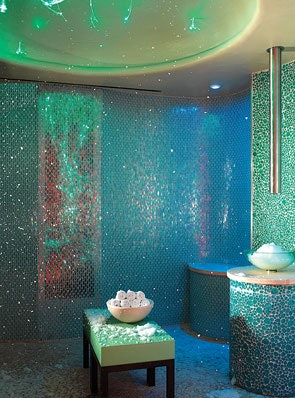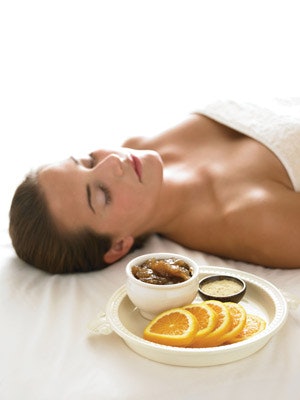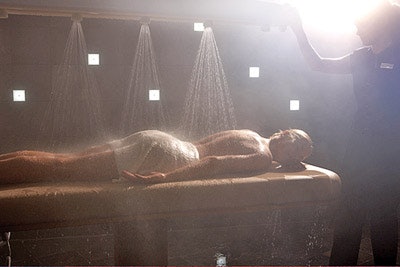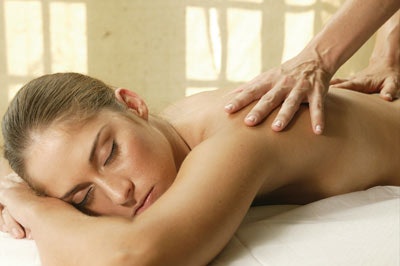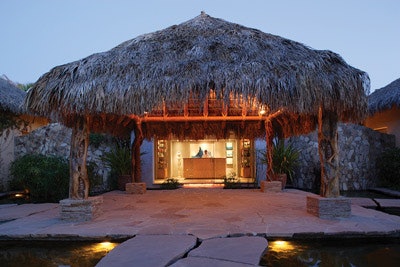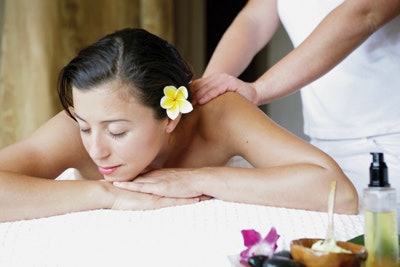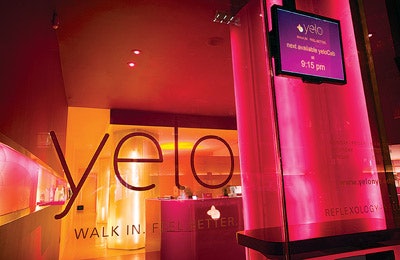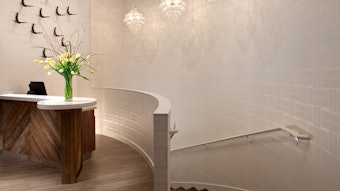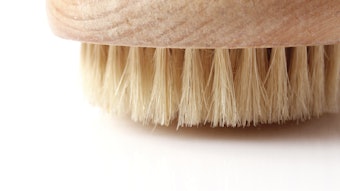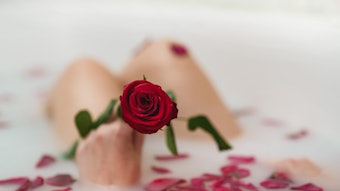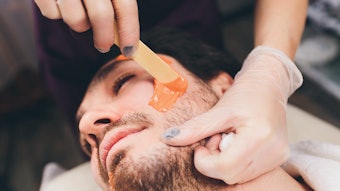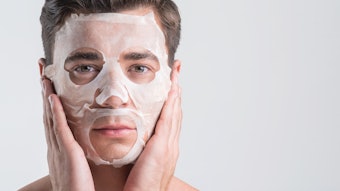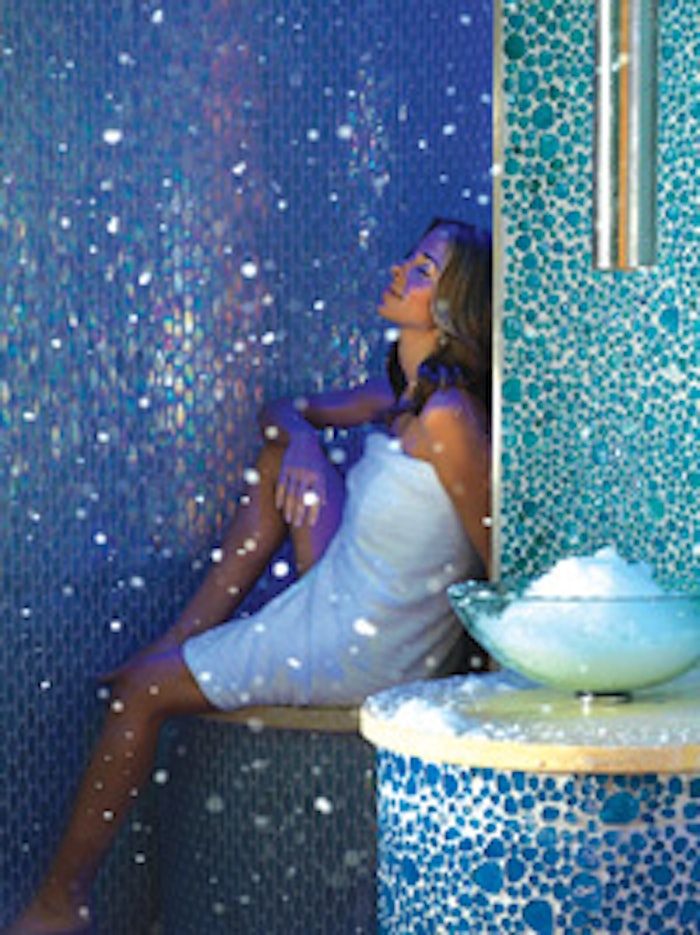
From therapeutic to authentic to life-changing, body treatment trends in today's spas are reflecting the maturing of an industry that is becoming more comfortable in its role as a promoter of well-being. Although fun, fluffy services are always in style, newer treatments in day and resort spas are taking a look at providing results--not necessarily the black and white results of medical spas--but more subtle approaches to improving the lives of clients.
The big chill
Often billed as a retreat from the normal spa service, menu items departing from the comfort of warmth lead spa-goers into a temperature that typically isn’t associated with comfort at all. In fact, upon first consideration, the idea of being doused in cold water or reclined in a frigid room doesn’t sound terribly appealing. However, despite this first impression, the use of cold can stimulate circulation, heal overworked muscles and result in feelings of invigoration.At Just Calm Down Spa in New York, the Polar Express Massage was introduced this past summer to provide therapy to athletes and those experiencing strained muscles or swelling post-surgery, as well as a cool escape from the heat of the season. The massage therapist places bags of cool water on the bed for a waterbed effect, and the client can choose a cucumber/lime or peppermint essential oil to be used during the service, both of which have cooling effects on the skin.
According to Maiya Thompson, a massage therapist at the spa, cold offerings are more than just a fun trend—they reflect the growth of the professional and the client alike. “Massage therapists are starting to have an extensive background in physical health rather than just offering massage for relaxation. And clients are more in tune with their bodies, so they are looking for alternative ways to get treatment,” she says.
Qua Baths & Spa at Caesers Palace in Las Vegas has expanded on this idea, building an entire room based on the benefits of cold. In true Vegas style, the Arctic Ice Room is as flashy as it is therapeutic, featuring fantastic effects and décor to nurture that fresh-from-Antarctica feeling. Clients can enjoy a constant snowfall in a 55°F blue-and-white tiled room that features a heated floor and benches, as well as tiny fiber optic lights that illuminate the walls and a shaved ice fountain that provides crushed ice chips to cool and exfoliate.
And although the result is breathtaking, spa director Jennifer Lynn explains it is all based on Roman bathing rituals. The Arctic Ice Room caps off a client’s voyage through the three Roman Baths—the tepidarium, a pool kept at body temperature; the caldarium, kept at 106°F to ease tension and soothe tired muscles; and the frigidarium, the cold plunge pool that invigorates—followed by the laconium room, a sauna. “By ending cold, clients are bringing their core body temperature down. It closes pores and stops perspiration,” says Lynn. “We love to say that it snows every day in Vegas.”
Cold and its involvement in spas’ past is not a new concept for Jean Kolb, spa director at Kohler Waters Spa in Kohler, Wisconsin, and Burr Ridge, Illinois. “When first looking at the principles of spa and water therapy, the use of hot and cold go back hundreds of years. People understood the benefits of warming and cooling the body,” she explains.
The spa’s newest location in Burr Ridge offers a variety of water treatments utilizing the cold, including the Aqua Tonic treatment, which alternates a warm-water Vichy shower experience with a bracing cold exfoliation, and the Circle of Tranquility room, which offers self-guided water rituals. Here, clients can enjoy a variety of shower and whirlpool offerings, most notably an eight-foot cold plunge pool to replenish and revive.
“People come out of it and they feel exhilarated and totally relaxed,” explains Kolb, who says, though 100% cold will contract muscles, alternating cold and warm is becoming very popular. She also mentions that, as the industry matures, spa clients are ready to take their treatments to the next level. “Massages are becoming part of a regular wellness routine for some clients, and they are looking for something new and exciting,” she notes. “Clients are becoming more spa savvy, and they want to feel good afterward and know that they’ve done something good for the body.”
If your spa wants to ice up its menu, there is only one thing to do … “Take the plunge,” laughs Kolb. “Experiment with it … the entire body, through the hair, on the feet, whatever, just go with it, play with it. You’ll find you come up with some of the most amazing treatments.”
A way of life
And just as Kohler Waters Spa and Qua are reaching into spas’ past and focusing on cold water, many facilities are beginning to focus on the significance of cultural history in interesting and innovative ways. At The Spa at Esperanza at the Esperanza resort in Cabo San Lucas, Mexico, spa director José Ramon García says Mexican culture is reflected throughout the design and hospitality of the resort, as well as through the native ingredients in spa services.
“We feel that the ingredients used in the treatments are a way of telling about our culture, and using natural products available in the area helps to enrich the spa experience,” he says. “From having a wrap with amaranth and honey to sipping a drink made out of chaya and prickly pear, it really takes you to another dimension.”
García believes more and more spas are combining indigenous elements from the environment with the heart and soul of the local people. This new play on “indigenous” treatments focuses not only on the ingredients that are native to an area, but on the people, customs and history tied to a location, as well.
No spa subscribes to this more completely than The Spa at Colonial Williamsburg in Williamsburg, Virginia. During the formative years of the United States—specifically from 1699 to 1780—the colony of Williamsburg was its political, educational and cultural center and the place where the fundamental concepts of the United States were nurtured by such founding fathers as George Washington and Thomas Jefferson.
As expected, this historic culture is embedded in the entire town, including the spa, which opened in the spring of 2007. According to Kate Mearns, spa director, “Being part of Colonial Williamsburg and the rich historical aspect here, it was only a natural fit to become the experts in the different wellness practices performed throughout the centuries.”
Sylvia Sepielli, through her company SPAd, helped develop the spa’s concept based on a continuum of wellness. Its five signature experiences are each based on a century—17th through 21st—and depict the wellness practices of that time through a modern-day interpretation. “When a client comes in, they want to do something authentic and unique,” explains Mearns. “Our 17th century experience is the first one we had inspiration for. It’s a two-hour treatment that depicts American Indian practices, such as sweat lodges to detoxify, cold plunges and treatment oils, such as angelica, which probably were used for insect protection.”
As a modern-day interpretation of this, the treatment begins with a detoxifying wrap using a cool aromatherapy towel to bring down the body temperature, like the cold plunge, and it finishes with a hot stone massage. “It’s one of my favorite services. It’s relaxing and uses a lot of local herbs that were used during that time period, as well,” says Mearns.
Another spa that brings a cultural focus to clients is Spa Grande at the luxurious Grand Wailea Resort Hotel and Spa in Wailea, Maui, Hawaii. Catering to the idea of an escape to nature, the spa works to keep its cultural offerings both unique and true to the island. “Especially in exotic locations, people have high expectations of finding something unique and linked to the culture,” says Cecilia Hercik, director of spa and sales operations for the spa. “They are a little more adventurous and want to learn and experience a little bit of the traditions. Hawaii is amazing because the culture is so alive.”
This living culture is depicted in one of the spas newest—and most authentic—treatments, the Pala’ua Journey, which follows ancient Hawaiian healing practices and incorporates native herbs that are infused with stone and the moon. The company, Pala’ua, puts the herbs in stone containers and waits for the full moon, then performs blessings over them.
The treatment is equally unique. It features traditional lomi lomi massage techniques. “It’s almost like a hula dance with the movements, flow and pressure,” says Hercik. Three different oils are available: one for women with hormonal concerns; one for body, mind and soul; and one that is herb-based and balancing. The massage lasts 50 minutes and is followed by an herbal infusion cream on the scalp with coconut, kukui oil and rosemary. A hot towel is placed to trap the heat, and then the esthetician moves to the feet and massages them with a cream and hot lava stones.
“The treatment is trained here, and the products are made in Hawaii and made with an intent,” says Hercik. “It was created to allow guests to experience a whole journey.” It is this focus of authenticity that makes one culture-based spa stand out from another.
Mearns offers the following advice to spas considering offering cultural treatments: “Do some research and really understand the culture and indigenous products. If you have an existing spa, sample your service concept and get ideas from current spa clients to get a consumer perspective,” she says. “You’ve got to make sure that it is real—not hokey—authentic, something they can believe in and see the benefits of, as well. There’s got to be some benefit to the service.” Hercik agrees, “It should be authentic. Also, be careful not to offend a culture that is alive. Reach out to someone who lives the way the culture dictates, and they can tell you the dos and don’ts. Sometimes you have to have permission to depict a culture in a service.”
Sweet slumber
If you are talking about the culture in the United States, lack of sleep is one of the major issues plaguing it. According to Nicolas Ronco, founder of New York’s Yelo, a wellness center based around the benefits of sleep, the first reason for the nation’s insomnia is the escalating pace of life. “It has really increased during the past 15 years,” he says. “Faxes, the BlackBerry*, the Internet, Wi-Fi—we are reachable everywhere and that’s really stressing people out.”
Lisa Hedley, founder and creative director of the Mayflower Inn & Spa in Washington, Connecticut, agrees. “We are chronic insomniacs, plugged into every device known to man, and those things create a series of bad habits that prevent people from sleeping well and sleeping the amount that they need.”
And although these two industry leaders agree, their methods are extremely different. At Yelo, which offers a variety of relaxation-based services, YeloNaps are the most requested menu item. Clients can purchase naps at a variety of different time intervals, and during the first visit, a questionnaire is filled out regarding sleep patterns and medical history, as well as how the client feels. Once this is known, the client selects a scent—options include orange flower, fig, mimosa and blackberry—and then music or sound—such as whales, nature, Mozart or Chopin.
Once their nap is created, they are installed in a sleep cabin and sit in a zero-gravity chair, which is the secret to a quick, quality nap, says Ronco. “Their knees are put above their heart, which helps them fall asleep quickly.” When it is time to wake the client, a sunrise simulation is created using LED lighting. In three minutes, people come back, open their eyes and leave. “They feel like they’ve taken a three-week vacation because, when they leave, they feel lighter and in a good mood,” he explains. Ronco came up with this concept as an overstressed, overworked insomniac and has secured corporate clients, such as Newsweek magazine and TimeWarner, that offer YeloNaps as an employee benefit.
Hedley has a completely different approach, one that is based in the luxury of a destination spa setting. “We approach sleep at the Mayflower by taking an integrative approach to people’s wellness. One of the benefits of a destination spa is that it takes clients out of the world, and it strips down day-to-day stress and starts to decompress people. Then we look at a variety of ways that we can help them relax and help them recognize how they build stress,” she says.
In one of the sleep programs hosted at the spa called Sleep Better, Sleep Well, relaxation and stress relief techniques are utilized, followed by a variety of modalities, including Thai yoga and meditation. A workshop is then held where guests and experts talk about strategies for better sleep. “Simple things can be done, such as, in the evening, turn down your world. Turn down your lights an hour before bed in preparation for sleep, turn off computers, TV, your BlackBerry* and get into your own inner world in a quiet way,” explains Hedley. After this, personal rituals can be developed specifically around sleep.
A third way to address the issue of sleep through the spa is by offering a treatment, such as the Vitamin Z service at Spa Radiance in San Francisco. Spa director Angela Umansky says the immediate benefits of a sleep treatment are deep relaxation, smoother, softer skin and a good night’s rest. “But, more importantly, sleep treatments help educate clients to create their own ongoing, healthy, at-home sleep habits. We liken creating sound sleep to developing glowing, radiant skin. It’s a practice,” she says.
Umansky and her team developed the treatment specifically for overly tired clients. “There’s only so much an eye cream can do for dark under-eye circles. Clients requested advice about how to wind down after a long day, so we came up with an ultra-soothing treatment and made sure clients went home with our Sleep Well Kit, which is a very common sense guide to a better night’s slumber,” she explains. Umansky sees this as an extension of the quick naps offered at facilities such as Yelo, and the services that are even provided in the spa’s relaxation area.
The treatment includes a Lavender Lullaby Salt Scrub and a Sleep Surrender Massage. The salt scrub features thermal spring salts that result in smooth skin and calming detoxification. After the scrub, guests enjoy the massage, an alpha-state inducing Swedish technique with body-mind soothing benefits.
When developing sleep treatments, Umansky suggests starting with your existing clients. “Talk with them and ask what new treatments they would like to see.” Hedley also believes anything that can help reduce stress and increase sleep quality will result in a spa’s main goal: enhancing the quality of clients’ lives.
Inspire a new focus
Fun, fascinating and beneficial, spas are offering new ways to intrigue clients while improving their lives and surprising them at the same time. By taking the lead from these innovative spas, the industry will continue to grow and inspire a new focus on the importance of well-being in an increasingly stressful world.
